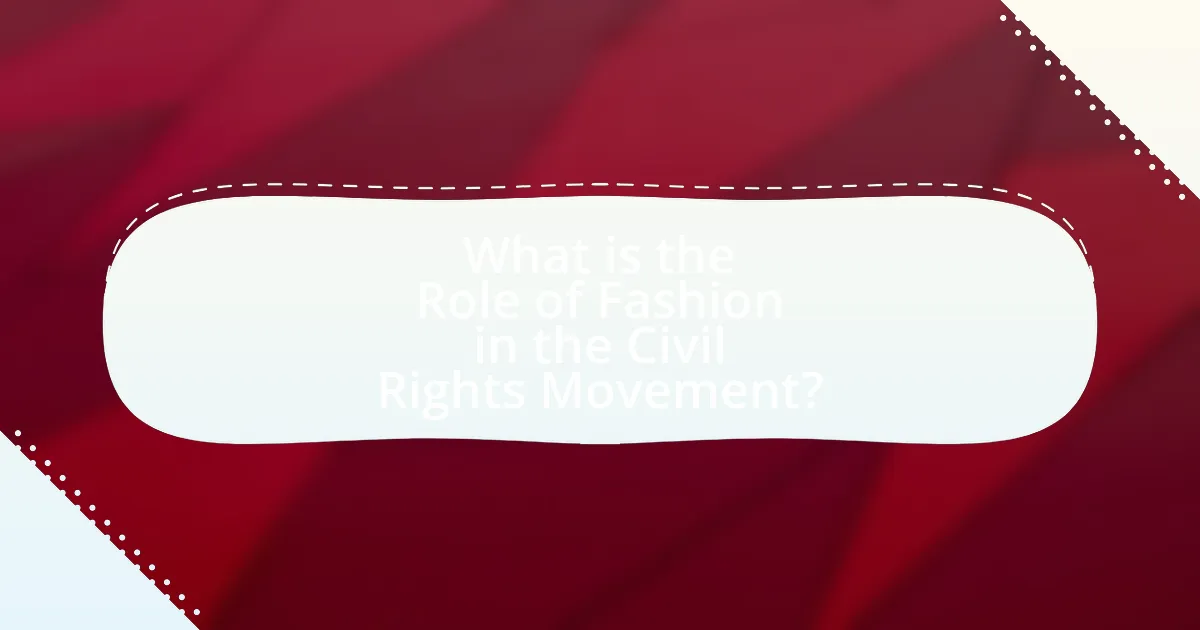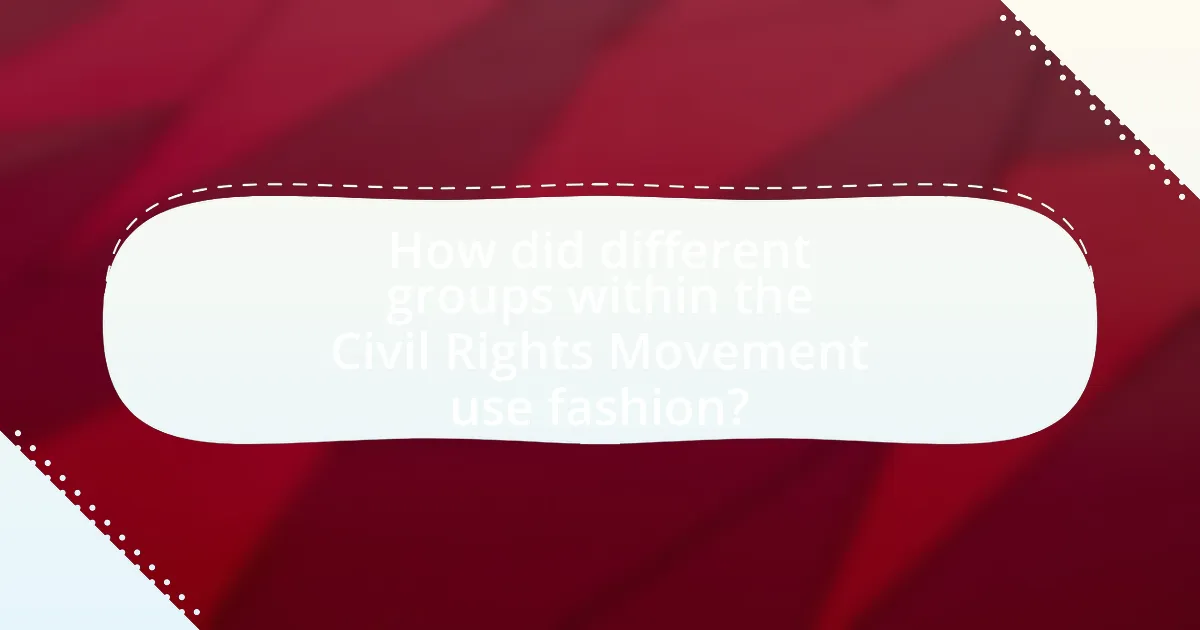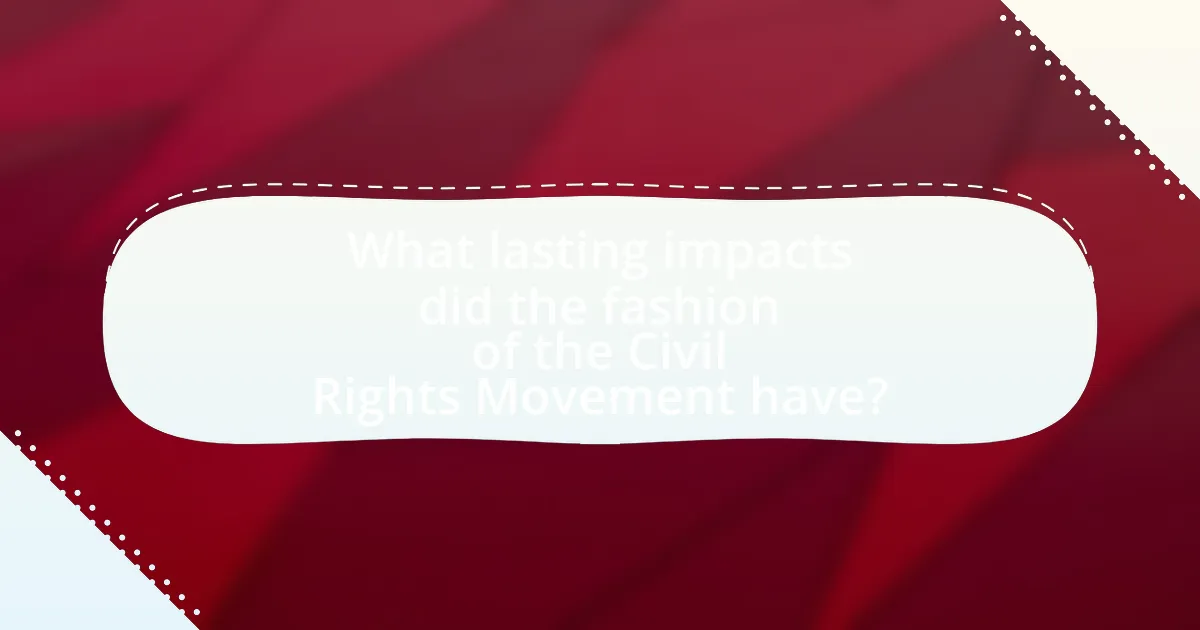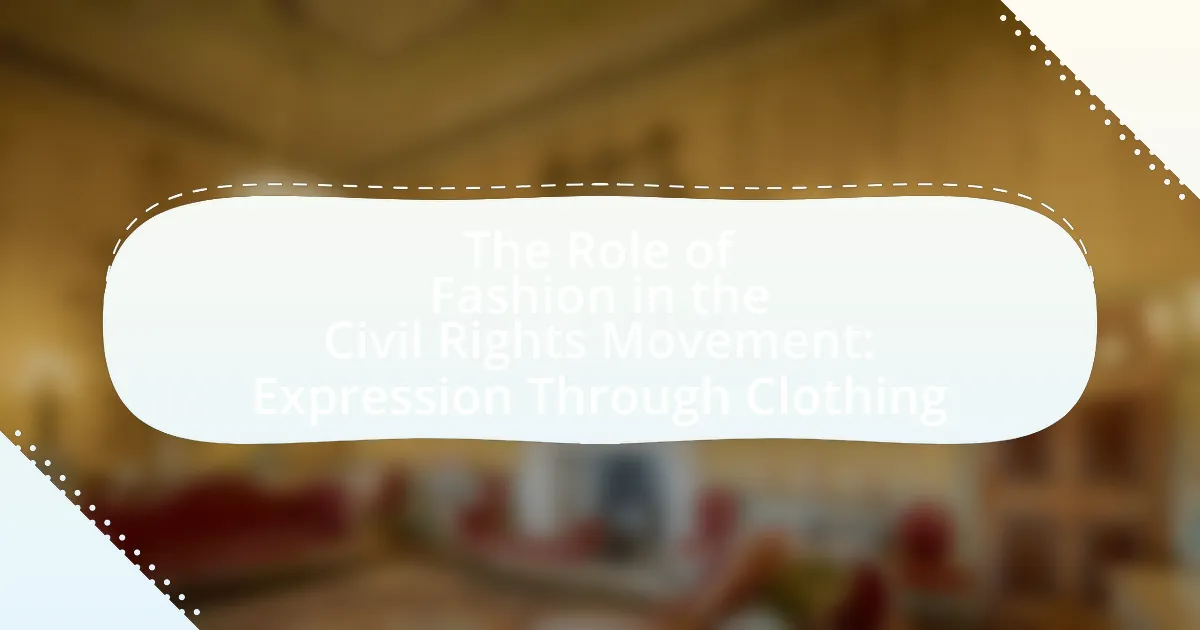The article examines the significant role of fashion in the Civil Rights Movement, highlighting how clothing served as a form of expression and a tool for social change. It discusses specific clothing items, such as the black beret and denim jackets, that became symbols of resistance and unity among activists. The article also explores how fashion choices reflected the values and goals of the movement, influenced public perception, and were utilized by different groups within the movement. Additionally, it addresses the lasting impacts of Civil Rights fashion on contemporary trends and the intersection of fashion with activism today.

What is the Role of Fashion in the Civil Rights Movement?
Fashion played a significant role in the Civil Rights Movement by serving as a form of expression and a tool for social change. Activists used clothing to convey messages of unity, pride, and resistance against racial discrimination. For instance, the adoption of the African American hairstyle known as the “Afro” symbolized a rejection of Eurocentric beauty standards and embraced cultural identity. Additionally, the use of specific attire, such as the black berets worn by the Black Panther Party, communicated solidarity and empowerment. Historical events, like the 1963 March on Washington, showcased participants wearing coordinated outfits to project a unified front, emphasizing the movement’s goals. Thus, fashion was not merely about aesthetics; it was a powerful medium for political expression and cultural affirmation during the Civil Rights Movement.
How did clothing serve as a form of expression during the Civil Rights Movement?
Clothing served as a powerful form of expression during the Civil Rights Movement by symbolizing resistance, unity, and cultural identity. Activists often wore specific garments, such as the black beret and leather jackets, to convey solidarity and assert their political stance. For instance, the Black Panther Party adopted a uniform that included black leather jackets and berets, which not only represented their commitment to social justice but also challenged racial stereotypes. Additionally, clothing choices like the use of African-inspired fabrics and styles during protests highlighted a reclaiming of cultural heritage and pride. This intentional use of fashion was evident in events like the March on Washington in 1963, where participants wore coordinated outfits to project a unified front. Thus, clothing became a visual language that communicated the values and aspirations of the movement, reinforcing the message of equality and justice.
What specific clothing items became symbols of the movement?
Specific clothing items that became symbols of the Civil Rights Movement include the black beret, worn by members of the Black Panther Party, and the denim jacket, which represented working-class solidarity. The black beret signified empowerment and unity among activists, while the denim jacket was adopted as a casual yet defiant statement against social injustice. These items were not only functional but also served as visual markers of identity and resistance during the movement, reinforcing the connection between fashion and political expression.
How did fashion choices reflect the values and goals of the Civil Rights Movement?
Fashion choices during the Civil Rights Movement reflected the values and goals of the movement by promoting unity, dignity, and resistance against oppression. Activists often wore clothing that symbolized their cultural heritage and aspirations for equality, such as the adoption of African-inspired styles and the use of the color black to signify solidarity. For instance, the Black Panther Party’s uniform of black berets and leather jackets conveyed a message of strength and defiance against systemic racism. Additionally, the use of clothing as a form of protest, such as the wearing of “I Am a Man” signs during the Memphis sanitation workers’ strike, highlighted the demand for respect and recognition of African American rights. These fashion choices served not only as personal expressions but also as collective statements that aligned with the movement’s goals of social justice and civil rights.
Why is fashion considered a powerful tool for social change?
Fashion is considered a powerful tool for social change because it serves as a medium for self-expression and a platform for activism. Throughout history, clothing has been used to challenge societal norms and convey messages of resistance, particularly during the Civil Rights Movement, where attire symbolized unity and identity. For instance, the adoption of specific styles, such as the African American community’s embrace of Afro hairstyles and traditional African garments, was a direct response to racial discrimination and a reclamation of cultural heritage. This use of fashion not only fostered a sense of belonging but also drew attention to social injustices, making it an effective vehicle for raising awareness and inspiring action.
How did fashion influence public perception of the Civil Rights Movement?
Fashion significantly influenced public perception of the Civil Rights Movement by serving as a powerful tool for self-expression and identity among activists. The clothing choices of figures like Martin Luther King Jr. and Malcolm X, which often included tailored suits and traditional African attire, projected dignity and strength, challenging prevailing stereotypes of African Americans. Additionally, the adoption of styles such as the Black Panther Party’s militant attire, which included berets and leather jackets, conveyed a message of empowerment and resistance. These fashion statements not only resonated within the movement but also captured media attention, shaping how the broader public viewed the struggle for civil rights. The visibility of these styles in protests and media coverage helped to humanize the movement, fostering empathy and support among diverse audiences.
What role did designers and brands play in supporting the movement?
Designers and brands played a crucial role in supporting the Civil Rights Movement by using their platforms to promote social justice and equality through fashion. Notably, designers like Anne Klein and brands such as Black-owned businesses created clothing that reflected the values of the movement, often incorporating symbols of resistance and empowerment. For instance, during the 1960s, the use of African-inspired patterns and styles became a statement of cultural pride and identity, aligning with the movement’s goals. Additionally, many designers participated in fundraising events and collaborated with civil rights organizations, further amplifying their support. This engagement not only provided financial backing but also helped to raise awareness about the struggles faced by African Americans, demonstrating the significant impact of fashion in advocating for social change.

How did different groups within the Civil Rights Movement use fashion?
Different groups within the Civil Rights Movement used fashion as a means of expression and solidarity. For instance, the Student Nonviolent Coordinating Committee (SNCC) emphasized simple, functional clothing to reflect their commitment to grassroots activism and equality, often wearing matching attire during protests to symbolize unity. In contrast, the Black Panther Party adopted a more militant style, featuring black leather jackets, berets, and sunglasses, which conveyed strength and defiance against oppression. Additionally, women in the movement often wore traditional African attire or styles that highlighted their cultural heritage, promoting pride and identity. These fashion choices were not merely aesthetic; they served as powerful symbols of resistance, community, and the broader struggle for civil rights, reinforcing the message of the movement.
What were the fashion choices of key figures in the movement?
Key figures in the Civil Rights Movement often chose clothing that symbolized dignity, unity, and resistance. For instance, Martin Luther King Jr. typically wore tailored suits, which conveyed professionalism and respectability, aligning with his philosophy of nonviolent protest. Rosa Parks famously wore a simple dress when she refused to give up her bus seat, representing the everyday struggles of African Americans. Additionally, Malcolm X was known for his sharp suits and bow ties, which projected a sense of pride and empowerment. These fashion choices were deliberate, as they aimed to challenge stereotypes and assert the identity and humanity of African Americans during a time of intense racial discrimination.
How did Martin Luther King Jr.’s style convey his message?
Martin Luther King Jr.’s style conveyed his message through the deliberate choice of formal attire, which symbolized dignity and respect. By consistently wearing suits and ties, King projected an image of professionalism and seriousness, aligning with the values of the Civil Rights Movement. This sartorial choice reinforced his commitment to nonviolent protest and equality, as it contrasted with the stereotypes often associated with African Americans during that era. King’s attire served as a visual representation of his ideals, promoting the notion that African Americans deserved the same respect and rights as all citizens.
What impact did figures like Rosa Parks have on fashion trends?
Figures like Rosa Parks significantly influenced fashion trends by promoting clothing that symbolized dignity and resistance. Parks’ choice to wear a simple, modest dress during her historic act of defiance in 1955 became emblematic of the Civil Rights Movement, inspiring others to adopt similar styles that conveyed strength and purpose. This shift in fashion reflected a broader cultural movement where clothing became a means of expressing identity and solidarity within the struggle for civil rights, as seen in the adoption of similar attire by activists during protests and marches. The impact of such figures is evident in how their fashion choices helped to redefine societal norms around race and class, making clothing a powerful tool for social change.
How did youth culture influence fashion in the Civil Rights Movement?
Youth culture significantly influenced fashion during the Civil Rights Movement by promoting styles that symbolized resistance and identity. Young activists adopted clothing that reflected their values, such as the use of African-inspired patterns and colors, which served to assert cultural pride and solidarity. For instance, the popularity of the Black Power movement in the late 1960s led to the embrace of natural hairstyles and clothing that celebrated African heritage, such as dashikis. This shift in fashion was not just about aesthetics; it was a form of protest against racial discrimination and a way to unify the youth in their fight for civil rights. The integration of these styles into everyday wear helped to challenge societal norms and foster a sense of community among young people engaged in activism.
What styles were popular among young activists?
Young activists during the Civil Rights Movement popularized styles that included casual, functional clothing such as denim jeans, t-shirts, and button-up shirts, often paired with jackets or coats. These styles were practical for demonstrations and reflected a sense of solidarity and unity among activists. The adoption of these clothing items was influenced by the desire for comfort and mobility during protests, as well as a rejection of formal attire that was often associated with the status quo. Additionally, the use of symbols like the black power fist on clothing became a significant expression of identity and resistance, reinforcing the movement’s messages.
How did music and art intersect with fashion during this period?
Music and art significantly influenced fashion during the Civil Rights Movement by serving as powerful forms of expression that reflected social and political sentiments. Artists and musicians, such as James Brown and Nina Simone, used their platforms to promote messages of empowerment and resistance, which were often mirrored in the clothing styles of the time. For instance, the adoption of African-inspired garments and the use of bold colors and patterns in fashion were direct responses to the cultural pride emphasized in music and visual art. This intersection is evidenced by the popularity of styles like the Afro hairstyle and the use of clothing as a statement against oppression, which were prevalent in both music performances and art exhibitions during the 1960s.

What lasting impacts did the fashion of the Civil Rights Movement have?
The fashion of the Civil Rights Movement had lasting impacts on cultural identity and social activism. Clothing choices during this period, such as the adoption of African-inspired styles and the use of symbols like the black beret, fostered a sense of unity and pride among African Americans. This fashion not only served as a form of self-expression but also became a visual representation of the struggle for equality, influencing future generations to use fashion as a means of political and social statement. For instance, the Black Panther Party’s uniform of black leather jackets and berets became iconic, symbolizing resistance and empowerment, which continues to inspire contemporary movements advocating for social justice.
How has the legacy of Civil Rights fashion influenced contemporary fashion trends?
The legacy of Civil Rights fashion has significantly influenced contemporary fashion trends by promoting themes of empowerment, identity, and social justice. Key elements such as bold colors, statement pieces, and culturally significant attire, which were prevalent during the Civil Rights Movement, continue to resonate in today’s fashion, reflecting a commitment to activism and self-expression. For instance, the use of African textiles and styles in modern streetwear not only honors cultural heritage but also serves as a form of protest against systemic racism. Additionally, designers like Dapper Dan have integrated historical references from the Civil Rights era into high fashion, demonstrating the enduring impact of this legacy on current trends.
What modern movements draw inspiration from the fashion of the Civil Rights era?
Modern movements that draw inspiration from the fashion of the Civil Rights era include the Black Lives Matter movement and various contemporary social justice initiatives. These movements often utilize clothing as a form of expression and solidarity, echoing the styles and messages of the Civil Rights era, such as the use of bold colors, African-inspired patterns, and slogans that promote equality and justice. For instance, the Black Lives Matter movement frequently incorporates T-shirts and accessories that feature powerful messages, reminiscent of the protest attire worn during the Civil Rights era, which aimed to raise awareness and foster community among activists.
How do current designers pay homage to the styles of the Civil Rights Movement?
Current designers pay homage to the styles of the Civil Rights Movement by incorporating elements such as bold colors, patterns, and silhouettes reminiscent of the era into their collections. For instance, designers like Dapper Dan and Pyer Moss have drawn inspiration from the iconic looks of activists and cultural figures, using fashion as a platform to address social justice issues. This homage is evident in the revival of styles like the African-inspired prints and tailored suits that were popular during the 1960s and 1970s, reflecting the movement’s emphasis on identity and empowerment. Additionally, collections often feature references to significant events and symbols from the Civil Rights Movement, reinforcing the connection between fashion and historical activism.
What lessons can we learn from the intersection of fashion and activism?
The intersection of fashion and activism teaches us that clothing can serve as a powerful medium for social change and identity expression. Historical examples, such as the Black Panther Party’s use of uniforms to convey solidarity and resistance, illustrate how fashion can symbolize political movements. Additionally, the rise of sustainable fashion movements highlights the importance of ethical consumption and environmental awareness, showing that fashion choices can reflect and promote activism. These instances demonstrate that fashion is not merely aesthetic but can be a strategic tool for advocacy and community building.
How can fashion be used today to promote social justice and equality?
Fashion can be used today to promote social justice and equality by serving as a platform for activism and raising awareness about social issues. Designers and brands increasingly create collections that reflect social movements, such as Black Lives Matter and LGBTQ+ rights, using their influence to advocate for change. For instance, brands like Pyer Moss and Savage X Fenty incorporate messages of inclusivity and representation in their campaigns, directly addressing systemic inequalities. Additionally, fashion events and runway shows often feature themes centered on social justice, engaging audiences in conversations about equity and representation. This approach not only highlights important issues but also mobilizes consumers to support brands that align with their values, thereby fostering a culture of accountability and advocacy within the industry.
What are some best practices for using fashion as a form of expression in activism?
Best practices for using fashion as a form of expression in activism include selecting clothing that embodies the message of the cause, utilizing symbols and colors that resonate with the movement, and promoting sustainable and ethical fashion choices. For instance, during the Civil Rights Movement, activists wore specific colors and styles to symbolize unity and resistance, such as the use of African fabrics and the color black to signify pride and solidarity. Additionally, incorporating messages into clothing, like slogans or imagery, can effectively communicate the activist’s stance. Research indicates that visual representation in fashion can significantly influence public perception and awareness, making it a powerful tool for advocacy.

Leave a Reply